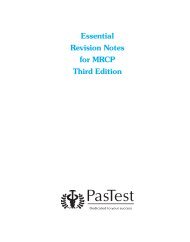MRCPCH 1: Essential Questions in Paediatrics - PasTest
MRCPCH 1: Essential Questions in Paediatrics - PasTest
MRCPCH 1: Essential Questions in Paediatrics - PasTest
- No tags were found...
You also want an ePaper? Increase the reach of your titles
YUMPU automatically turns print PDFs into web optimized ePapers that Google loves.
11. CardiologyMultiple True–False <strong>Questions</strong>1.1 Muscular ventricular septal defects (VSDs) A do not require SBE prophylaxis B usually cause a heart murmur <strong>in</strong> the first day of life C if large, are closed by catheter procedures <strong>in</strong> 10% of cases D do not have conduction tissue runn<strong>in</strong>g on their <strong>in</strong>ferior marg<strong>in</strong> E if large, usually cause heart failure before the child is 4 days old1.2 Scimitar syndrome A is usually associated with a hypoplastic left lung B can be palliated by coil occlusion <strong>in</strong> the cardiac catheter laboratory C will show dextrocardia on the X-ray as a result of situs <strong>in</strong>versus D is associated with abnormal pulmonary arterial supply E is usually associated with abnormal radii1.3 On the first day of life, the follow<strong>in</strong>g may be found <strong>in</strong> neonateswith congenital heart disease: A a harsh pansystolic murmur with the diagnosis of ventricular septaldefect B severe cyanosis <strong>in</strong> unobstructed total anomalous pulmonary venousconnection C a harsh systolic murmur <strong>in</strong> transposition of the great arterieswithout associated defect D severe acidosis and poor pulses with hypoplastic left heart syndrome E severe cyanosis and acidosis <strong>in</strong> a baby with Down syndrome andatrioventricular septal defect1.4 The follow<strong>in</strong>g is true of persistent ductus arteriosus: A it is def<strong>in</strong>ed as persistence of ductal patency beyond 1 week afterthe date the baby should have been born B on auscultation, a cont<strong>in</strong>uous murmur <strong>in</strong> the right <strong>in</strong>fraclaviculararea is heard C it may present as heart failure with poor peripheral pulses D closure is usually undertaken <strong>in</strong> the catheter laboratory with coil ordevice at 1 year E if it is large, surgical ligation is recommended at 1–3 months
















